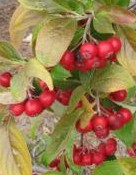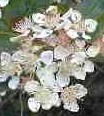 A native of thickets in wet areas such as bogs and swamps from Nova Scotia to Florida and west to Michigan, Missouri, and Texas, this deciduous shrub is a member of the rose family, Rosaceae, that also includes cherry, almond, and lady’s mantle. It grows 6-10′ tall and has reddish brown exfoliating bark. The elliptic, 3-5″ long leaves are glossy dark green above, pubescent grayish-green beneath, and turn bright red in the fall. In spring, plants bear clusters of white t0 pale pink flowers that are 1/3″ across and have 5 petals. The flowers are attractive to butterflies and other pollinators and are followed by glossy red berries 1/4″ across that are edible but so astringent that they are usually not eaten by most wildlife and persist into winter. Red chokeberry tolerates drought but does not do well in dry, shallow, alkaline soil. It is leggy but suckers freely and can form a substantial clump that looks well at a woodland’s edge or along the edges of a steam or pond. Red chokeberry is a good choice for borders, streamside, woodland and butterfly gardens. The genus name, Aronia, is the Greek word Aria for a species of Sorbus, to fruit of which resemble that of chokeberry. The specific epithet, arbutifolia, comes from the Latin Arbutus, the genus of the strawberry tree, and folia meanig leaf, and refers to the similarity of the leaves.
A native of thickets in wet areas such as bogs and swamps from Nova Scotia to Florida and west to Michigan, Missouri, and Texas, this deciduous shrub is a member of the rose family, Rosaceae, that also includes cherry, almond, and lady’s mantle. It grows 6-10′ tall and has reddish brown exfoliating bark. The elliptic, 3-5″ long leaves are glossy dark green above, pubescent grayish-green beneath, and turn bright red in the fall. In spring, plants bear clusters of white t0 pale pink flowers that are 1/3″ across and have 5 petals. The flowers are attractive to butterflies and other pollinators and are followed by glossy red berries 1/4″ across that are edible but so astringent that they are usually not eaten by most wildlife and persist into winter. Red chokeberry tolerates drought but does not do well in dry, shallow, alkaline soil. It is leggy but suckers freely and can form a substantial clump that looks well at a woodland’s edge or along the edges of a steam or pond. Red chokeberry is a good choice for borders, streamside, woodland and butterfly gardens. The genus name, Aronia, is the Greek word Aria for a species of Sorbus, to fruit of which resemble that of chokeberry. The specific epithet, arbutifolia, comes from the Latin Arbutus, the genus of the strawberry tree, and folia meanig leaf, and refers to the similarity of the leaves.
Type: Deciduous shrub
 Outstanding Feature: Red berries; fall coloration
Outstanding Feature: Red berries; fall coloration
Form: Upright when young; arching and vase-shaped in maturity
Growth Rate: Slow to medium
Bloom: Clusters of white flowers in mid spring
Size: 6-10’ H x 3-5’ W
Light: Full sun to partial shade but produces more fruit in full sun
Soil: Average, well-drained, slightly acidic; tolerates both wet and dry soils.
Hardiness: Zones 4-9
Care: Low maintenance; pruning is not usually necessary
Pests and Diseases: None of significance but susceptible to leaf spots and twig/fruit blight.
Propagation: Seed, collected in autumn and stratified for 3 months at 41o F.; leaf cutting; suckers
Outstanding Selections:‘Brilliant’ and ‘Brilliantissima’ ’(more compact, more abundant larger berries, better fall coloration than species)
